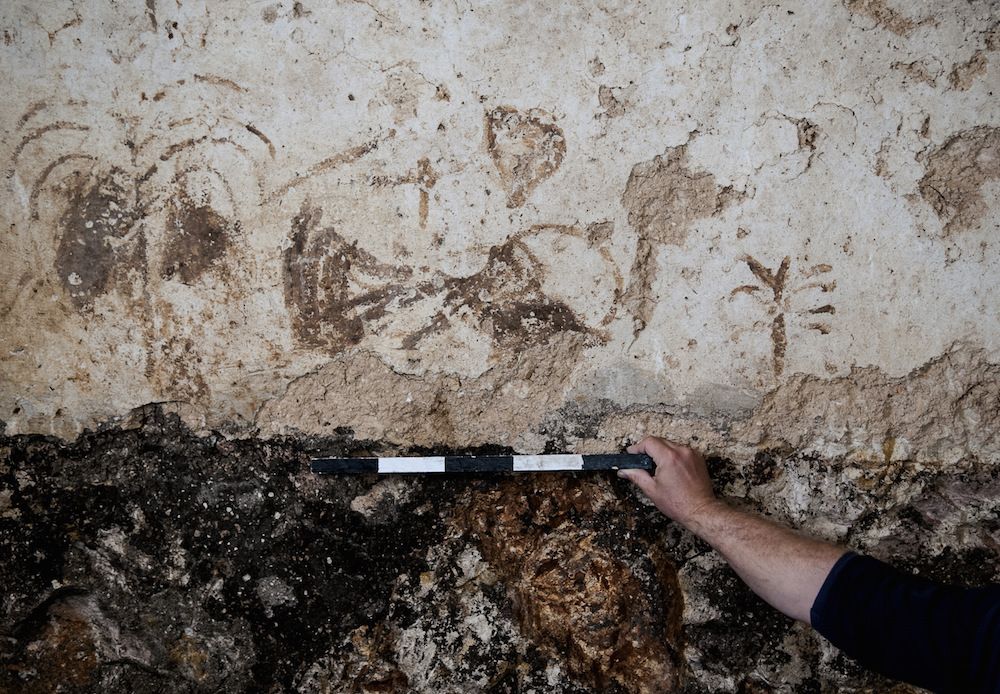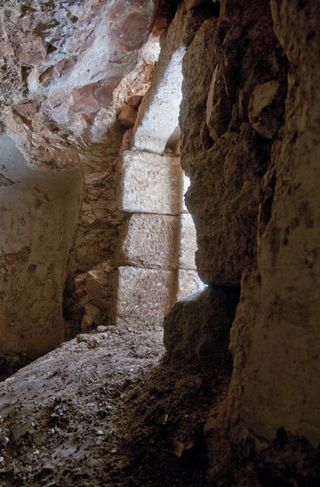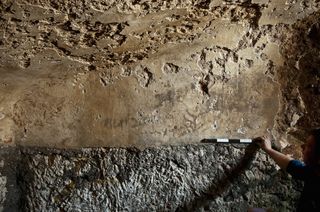2,000-Year-Old Ritual Message Is Uncovered…Then Begins to Vanish!

An enigmatic message, hidden for 2,000 years inside an underground cave, was recently uncovered in Israel.
And archaeologists who uncovered the mysterious message had to work quickly, as the symbols and text began to vanish as soon as they were exposed to the elements.
The message, a series of symbols and writings painted and carved onto the side of a ritual bath (or mikveh), was discovered about two months ago in the Arnona quarter of Jerusalem. Officials from the Israel Antiquities Authority (IAA) were performing a routine inspection of a construction site when they found the subterranean facility, which boasts its own anteroom (a sort of lobby area), complete with benches for ancient bathers. [The Holy Land: 7 Amazing Archaeological Finds]
The symbols adorning the plaster sides of the bath include a boat, palm trees, various plant species and possibly a menorah. Some of the markings are crafted with soot or mud, while others are carved into the bath. The words that decorate the bath are Aramaic, but they are written in cursive Hebrew script, which was not an unusual way to write Aramaic during the Second Temple period (538 B.C. to A.D. 70) according to the IAA.

"Such a concentration of inscriptions and symbols from the Second Temple period at one archaeological site, and in such a state of preservation, is rare and unique and most intriguing," Royee Greenwald and Alexander Wiegmann, excavation directors for the IAA, said in a statement.
The researchers excavating the site are familiar with most of the symbols displayed on the bath (the vegetation and boats) because these drawings were commonly used to decorate baths and other spaces during the Second Temple period. However, the drawing of what could be a menorah has the researchers stumped. Ancient people of this period typically refrained from drawing sacred objects, such as the multi-branched lampstand that has long served as a symbol of Judaism, according to the IAA.
The presence of the menorah could change the message conveyed collectively by these ancient symbols, according to Greenwald and Weigmann, who said, on the one hand, the symbols can be interpreted as "secular," but, on the other hand, they could be "symbols of religious significance and deep spirituality."
Sign up for the Live Science daily newsletter now
Get the world’s most fascinating discoveries delivered straight to your inbox.
The IAA has not yet released information about what the Hebrew-scripted writings say. But researchers are actively trying to piece together the connection between these writings and the symbols drawn on the bath, according to the IAA.

Of course, the researchers would also like to figure out who created the symbols and written message and why he or she (or they) may have done so. So far, they've suggested a few different possibilities. Perhaps these markings are the work of an ancient prankster (making them the Second Temple period equivalent of bathroom stall graffiti). Or maybe a deeply religious person created the enigmatic message, the researchers speculated. The message may have been drawn during the destruction of the Temple or the war that raged afterward, IAA officials suggested in the statement.
Regardless of the story behind the markings, researchers have had to work quickly to keep the symbols and writings from disappearing forever. The markings, which are very sensitive to exposure to light and air, were processed at the site of the ancient bath and then taken to the IAA's conservation laboratories. In the future, these messages from the past will be on display to the public.
Follow Elizabeth Palermo @techEpalermo. Follow Live Science @livescience, Facebook & Google+. Original article on Live Science.

Elizabeth is a former Live Science associate editor and current director of audience development at the Chamber of Commerce. She graduated with a bachelor of arts degree from George Washington University. Elizabeth has traveled throughout the Americas, studying political systems and indigenous cultures and teaching English to students of all ages.










